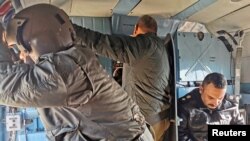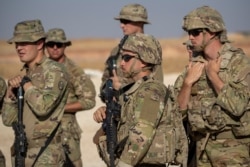Hopes of delivering the Islamic State a lasting defeat in Iraq and Syria have, for now, fallen by the wayside, according to officials with the U.S.-led coalition, despite a ramped-up crackdown on the terror group’s network of cells and facilitators.
"It’s more about keeping down ISIS,” an official with the U.S.-led coalition told VOA, using an acronym for the terror group. "Pressuring ISIS to capture/kill terrorist fighters, destroy hideouts and disrupt smuggling networks.”
The admission runs contrary to previously stated U.S. policy and even the coalition’s long-term goals, affirmed just last month, “to achieve a full and enduring defeat” of IS, not just in Iraq and Syria but worldwide.
It also comes as both Iraqi forces and U.S.-backed Syrian Democratic Forces have touted success in recent campaigns to find and eliminate IS fighters and hideouts, including one SDF operation in early June that resulted in at least 80 arrests along the Iraq-Syria border, as well as a more recent Iraqi operation hunting IS leaders and smugglers.
But it has not been enough.
In an interview with VOA on Wednesday, the top general at U.S. Central Command said eliminating IS in Iraq and Syria might never be possible.
"There's always going to be a low-level ISIS problem,” CENTCOM Commander General Kenneth “Frank” McKenzie said. “I believe that's going to be endemic. I don't think it's going to go away.”
Part of the difficulty in delivering IS an “enduring defeat” in Iraq and Syria comes down to sheer numbers.
According to U.S. intelligence estimates, the terror group is believed to have 14,000 to 18,000 fighters across the two countries, an estimate that has changed little in the past year. And while some Iraqi or SDF operations have resulted in dozens of arrests, many manage to catch or kill only a handful of IS fighters or operatives at a time.
فجر اليوم الأربعاء، شرعت قوات جهاز مُكافحة الإرهاب @iraqicts وبإسناد جوي من طيران التحالف الدولي @CJTFOIR بعملية أمنية في وادي الشاي جنوب مُحافظة #كركوك تمكن فيها أبطالُنا من قتل (٦) إرهابيين من فلول عصابات #داعـش الإرهابية. pic.twitter.com/GBBT9nblw6
— يحيى رسول | Yehia Rasool (@IraqiSpoxMOD) July 15, 2020
Even the increased tempo of anti-IS operations – 26 in Iraq alone during the second week of July – has not been enough to make a significant dent in IS numbers.
There has also been a growing recognition among U.S. officials that despite high-profile successes, such as the destruction of the terror group’s self-declared caliphate in Iraq and Syria and the killing of former leader Abu Bakr al-Baghdadi, IS has adapted.
Analysts contend some of that is likely because of the strengths of IS as a terror group.
“They are surprisingly frank about how they assess not only their capabilities and capacity, but also that of their adversaries,” Haroro Ingram, a senior research fellow at George Washington University's Program on Extremism, said during a webinar Tuesday.
“They demonstrate a relatively methodical approach to assessing risk and threat,” he added, cautioning that while the terror group’s rhetoric may suggest it seeks perfection and the elimination of all of its enemies, its military operations are often focused on just figuring out how to “out-compete” its adversaries.
Craig Whiteside, an associate professor at the U.S. Naval War College and a co-author with Ingram of The ISIS Reader: Milestone Texts of the Islamic State, also cites the terror group’s move to abandon defense of its self-declared caliphate in order to prioritize survival.
“They transitioned to this kind of uniform insurgency a lot earlier than we understood,” he said, noting that the group’s ability to function coherently has not been affected.
“They've really got their organizational practices down," Whiteside said. “Their leadership succession has gone on flawlessly. They've managed to hold on to these affiliates outside, which helps give them some legitimacy inside Iraq and Syria.”
Pentagon Correspondent Carla Babb contributed to this report.











